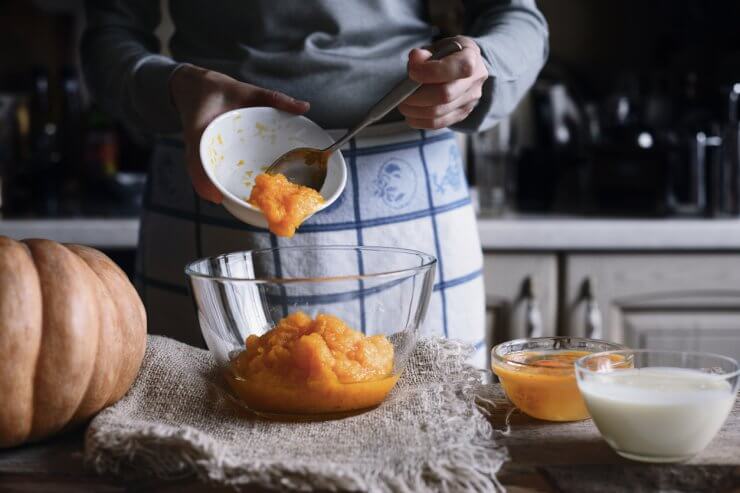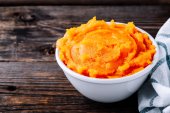
There’s something about homemade pumpkin purée that just feels like fall wrapped up in a cozy kitchen. I’ve always found myself with a handful of pumpkins post-Halloween—thanks to my ambitious carving plans and, of course, my daughter’s enthusiasm for pumpkin patches. Instead of watching them slowly decay on the porch (we’ve all been there), I like to turn those plump, orange gourds into a rich and creamy homemade pumpkin purée. It’s a culinary ritual that not only prevents waste but also sets the stage for all the delicious pumpkin dishes that come with cooler weather.
Pumpkin purée is the unsung hero in so many recipes, from the classic pumpkin pie to savory soups and even my weekday oatmeal (trust me, a spoonful of this stuff will change your morning game). While canned pumpkin purée is convenient, making your own adds a depth of flavor and freshness that store-bought versions can’t touch. And, if we’re being honest, canned pumpkin isn’t even all pumpkin—it’s usually a blend of squashes. So, if you’re after that true pumpkin essence, rolling up your sleeves and making it yourself is the way to go.
A Little Pumpkin History
Pumpkins have a long history in North America, where they were one of the staple crops cultivated by Native Americans. They used pumpkins in everything from stews to desserts, and they roasted the seeds, much like we still do today. As fall foods go, pumpkin is practically royalty. Its mildly sweet flavor and creamy texture make it a versatile ingredient, equally suited to a warm, spicy pie or a savory risotto. What makes pumpkin purée so special is its ability to blend effortlessly into whatever recipe it graces, offering a subtle richness without overpowering other flavors.
If you’ve only ever bought your pumpkin purée from a can, you’re in for a pleasant surprise. Making your own is surprisingly easy, and the taste is far superior to the canned variety. Plus, it’s a fun way to use up those pumpkins that are about to pass their prime. And don’t worry—if the pumpkins you carved for Halloween are still in good shape, you can use them too (just be sure to get rid of the seeds and stringy bits). Homemade pumpkin purée is a real game-changer, elevating your fall recipes with its fresher, fuller flavor.
Introducing the Recipe
Now, let’s talk about this simple and satisfying recipe for homemade pumpkin purée. It’s a straightforward process: all you need is a pumpkin (preferably a sugar pumpkin), an oven, and a food processor. Roasting the pumpkin helps bring out its natural sweetness and softens the flesh, making it easier to blend into a silky-smooth purée. One of the great things about this recipe is its flexibility—you can adjust the texture depending on what you plan to use it for. Need it thicker for pies? Leave it as is. Want something more soup-like? Add a little water while blending.
Print
Delicious Pumpkin Purée
Some recipes, like our pumpkin pie recipe, call for canned pumpkin or pumpkin purée. Don’t let that extra step scare you off—pumpkin purée is delicious in all sorts of recipes, including soup and pie. You can purée it to the consistency you need.
- Prep Time: 10 minutes
- Cooling Time: 20 minutes
- Cook Time: 1 hour 30 minutes
- Total Time: 2 hours
- Yield: Serves 4 to 8 depending on how you use it
- Category: Bakery
Ingredients
- One sugar pumpkin (the size depends on what you want to use it for)
- Food Processor (equipment)
Instructions
- Preheat oven to 350 degrees F
- Cut your sugar pumpkin in half.
- Scrape out the insides.
- Save the pumpkin seeds for roasting.
- Line a baking sheet with foil or parchment paper.
- Place the pumpkin halves cut side down on the baking sheet.
- Bake for 60 to 90 minutes, until the pumpkin is fork-tender.
- Remove pumpkin from the oven and flip it over to let it cool.
- Scoop out the pulp to use in recipes for soup, bread, muffins, and more.
- Purée in a food processor to the consistency you need for a given recipe.
- Refrigerate or freeze unused pulp in an airtight container.
I love making this purée in big batches because it freezes beautifully, meaning I can enjoy pumpkin treats long after fall has passed. It’s also incredibly versatile: I’ve used it in pies, pancakes, and muffins, but also in savory dishes like soups, risottos, and even as a pasta sauce base.
The Ingredients
The beauty of homemade pumpkin purée lies in its simplicity. Here’s what you’ll need:
- One sugar pumpkin: Sugar pumpkins, also called pie pumpkins, are smaller and sweeter than the larger varieties used for jack-o-lanterns. They have a smoother texture and richer flavor, which makes for a better purée. If you’re using a pumpkin leftover from Halloween, make sure it’s still fresh and not too dry or stringy.
- A food processor: You’ll need this to blend your roasted pumpkin into a smooth purée. If you don’t have one, a blender works too, but you may need to work in smaller batches.
Roasting Your Pumpkin
The key to a delicious purée is in how you roast your pumpkin. I like to cut the pumpkin in half, scoop out the seeds (which you can save and roast later for a snack), and place it face-down on a baking sheet. Roasting it this way allows the heat to distribute evenly, caramelizing the natural sugars in the pumpkin and giving it that deep, rich flavor we’re after. You’ll know it’s ready when you can easily pierce the flesh with a fork. After it cools down a bit, scoop out the soft insides and toss them in the food processor.
The first time I made pumpkin purée, I thought it would be a lot harder than it actually was. I remember standing in my kitchen, slightly intimidated by the whole pumpkin before me, wondering if I’d bitten off more than I could chew (pun intended). But after slicing through the pumpkin (with only minimal struggle!), the rest was smooth sailing. The smell of roasting pumpkin filled the house, a warm and comforting scent that felt like autumn itself.
One thing that surprised me was how much pumpkin flesh I got from just one small pumpkin. I ended up with several cups of purée, far more than I needed for the pie I was planning. That’s when I realized how handy it is to have extra pumpkin purée on hand. It freezes beautifully, so I always stash some away for future recipes.
The Taste and Texture
If you’ve only ever used canned pumpkin purée, the taste of homemade might surprise you. It’s fresher and more vibrant, with a natural sweetness that enhances both sweet and savory dishes. The texture is smooth, creamy, and luscious—a perfect base for everything from pies to soups. When I used it for a pumpkin pie, the difference was night and day. The filling was silkier, and the flavor had more depth. It’s also great in savory dishes, like a velvety pumpkin soup or stirred into risotto for an extra touch of fall flavor.
Variations and Substitutions
While sugar pumpkins are ideal, don’t worry if you don’t have one on hand. Any small, sweet pumpkin or even a butternut squash can work in a pinch. I have also used all of those fun blue and orange pumpkins, which are particularly delicious. Cinderella and Jarrahdale work quite well and have a lot of sweet flesh with few seeds, making them great puree and pie pumpkins (if not a bit harder to slice and put in the oven!).
I’ve also experimented with adding a little nutmeg or cinnamon to the purée when using it in sweet recipes—just a pinch to bring out the natural flavors. If you’re making a savory dish, try adding a touch of garlic or sage to give it a more robust flavor.
If this is your first time making homemade pumpkin purée, here are a few tips to help you along the way:
- Use a sugar pumpkin or pie pumpkin for the best flavor and texture.
- Roast the pumpkin halves cut-side down to ensure even cooking.
- Make sure to let the pumpkin cool before scooping out the flesh—trust me, it’s much easier!
- Blend the purée in batches if necessary, depending on the size of your food processor.
- Store the purée in an airtight container in the fridge for up to a week, or freeze it for longer storage.
- If your purée is too thick, add a splash of water while blending to achieve your desired consistency.
Making homemade pumpkin purée is one of those small kitchen projects that feels rewarding every time. The flavor is richer and fresher than anything you’ll find in a can, and it’s incredibly versatile. Whether you’re baking up a pumpkin pie, stirring it into soup, or freezing it for future use, this homemade purée is a cupboard or freezer essential.
Want to start growing your own pumpkins? Whether your goal is to decorate, cook, can and bake, or cultivate a blue-ribbon giant, we’ve got you covered with our Pumpkin Gardening Guide. Check it out now for everything you need to know about planting, tending, and harvesting pumpkins!
Give it a try, and let me know how it turns out for you in the comments below—I’d love to hear about your pumpkin adventures!


 Previous
Previous

